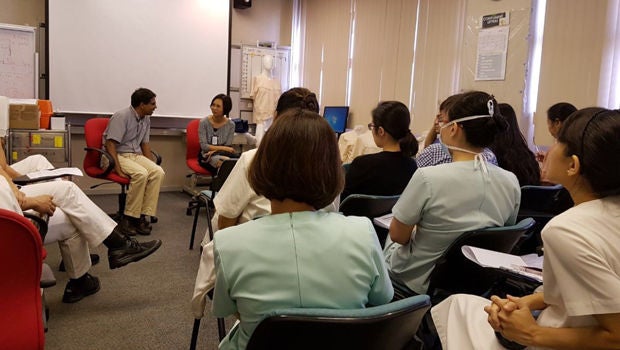
Multidisciplinary discourse, such as at the lunchtime talk, brings better patient care.
Allied health professionals form an integral part of Lung SDDC in providing holistic care for patient.
It was lunchtime. Some 20 healthcare professionals, including respiratory medicine physicians, intensivists, palliative care physicians, rehabilitation medicine physicians, nurses and many allied health professionals (physiotherapists, medical social workers, respiratory therapists, dieticians, psychologists among others) gathered, not for a social meal together, but to discuss the case of a patient with complex lung ailments.
Different professions, same patient
As discussion started on the case presented before them, the professionals listened to one another’s take on the patient and shared their views. By the time lunch hour was over, everyone had a clearer picture of how they could collectively improve the patient’s well-being.
The lunchtime discussion is one of the initiatives from SingHealth Duke-NUS Lung Centre’s (Lung SDDC) to help healthcare professionals understand one another’s work and learn best practices for their patients’ benefit.
Sometimes a simple realisation, such as learning from a nurse how involving a medical social worker early provides more assurance to patients and their families, helps the care team become more effective.
Patients with complex lung diseases such as post-Acute Respiratory Distress Syndrome and Idiopathic Pulmonary Fibrosis often have an equally complex diagnostic and treatment regime that involves multiple consultations across different medical departments. The Lung SDDC brings the different professions together to provide a one-stop service to these patients, reducing wait time and allowing medical staff to collaborate more closely.
A part of complete care
Integral to the holistic care of lung patients are Allied Health Professionals (AHPs).
When breathing becomes laborious, as it does for many patients with lung ailments, mobility is restricted and daily activities become onerous.
Physiotherapists come into the picture to help restore, replace or teach compensatory strategies so that patient can remain functional independence and enjoy reasonably good quality of life.
“When patients see the different professions working together, they are also more confident that they will receive good care from us.”
Dietitians come in to ensure they get the right nutrition and adequate calorie intake; psychologists if they have anxiety and depression; respiratory nurses to quit smoking; or medical social workers to cope with psychosocial changes due to their medical conditions.
Ong Hwee Kuan, Senior Principal Physiotherapist at SGH, explained, “Patients with breathing difficulties often benefit from a structured pulmonary rehabilitation programme, where specific exercises are prescribed to improve their stamina. We also teach coping strategies for patients with lots of secretions, those who cannot cough well, or have abnormal breathing.”
Hwee Kuan, who is Head of the Education and Staff development Unit of SGH Physiotherapy, strongly supports its multidisciplinary approach.
She said, “The value of an SDDC is that it provides a platform to bring doctors, nurses and AHPs together through joint consultations and provides more opportunities for communication and collaboration.
“For patients with complex conditions, it really helps to have an integrated approach as no single person can have a complete purview of the patient.”
The AHPs work together to improve the quality of care. For example, a group of respiratory physicians, respiratory therapists, speech therapists, and physiotherapists along with nurses has recently teamed up to optimise management of tracheostomy (opening of direct airway into the windpipe).
Physiotherapists in the SDDC are collaborating with respiratory physicians to investigate factors that prevent and enable patients to participate in pulmonary rehabilitation. They are also looking into how a portable oxygen supply can improve patient mobility.
An inter-professional approach to training
Beyond the areas of clinical care and research, physiotherapists in Lung SDDC have also taken an inter-professional approach to training through its Physiotherapy Residency programme.
Started three years ago, the programme trains physiotherapists who wish to specialise in cardiopulmonary care. The residents get to learn from specialties outside their own department or institution and participate in attachments at different settings: from the inpatient and outpatient wards, intensive care units to the pulmonary rehabilitation programme.

Nurul Aini Binte Bari (above, left) was the first physiotherapist in SGH to complete the two-year residency programme. “I was attached to the Lifestyle Improvement & Fitness Enhancement (LIFE) centre for three months and worked with patients suffering from metabolic disorders such as weight management issue and osteoporosis.
“I also learnt how to manage cardiac patients based in National Heart Centre Singapore (NHCS) during my three months attachment with NHCS Physiotherapy Department.”
“Not only have I gained a better understanding of the organisation from acute setting to chronic disease management and outpatient services, I now understand the bigger picture when helping each patient.
“Now, I don’t only help them become more mobile and facilitate early discharge, but I also encourage them to take ownership of their personalised rehab goals.”
"The value of an SDDC is that it provides a platform to bring doctors, nurses and AHPs together through joint consultations and provides more opportunities for communication and collaboration."
Working side-by-side with doctors and nurses allows Nurul’s views to be factored into the care of the patient more seamlessly.
During her attachment, Nurul met a patient who had ICU-acquired weakness and had a tracheostomy from prolonged mechanical ventilation. With the knowledge gained from her ICU attachment, she was able to plana more comprehensive rehabilitation programme for the patient during his ICU stay.
Hwee Kuan acknowledged that an integrated approach has led to greater recognition of AHPs’ work and better perception of the professions. She added, “When patients see the different professions working together, they are also more confident that they will receive good care from us.”













 Get it on Google Play
Get it on Google Play